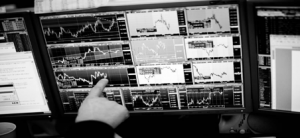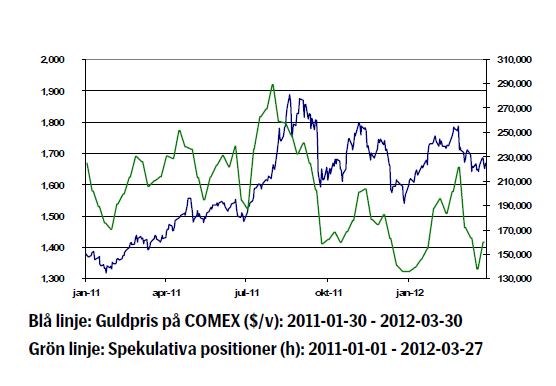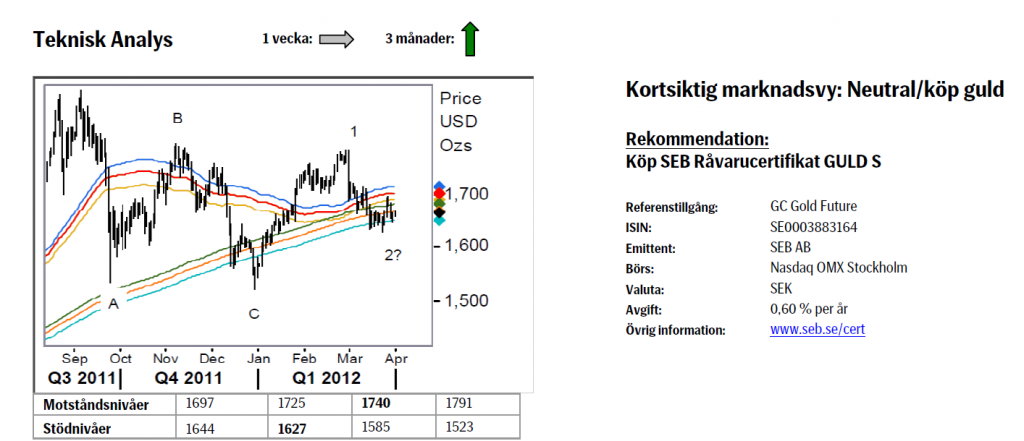Analys
SEB – Råvarukommentarer vecka 14 2012
Sammanfattning: Föregående vecka
- Energi: -2,68 %
UBS Bloomberg CMCI Energy TR Index
- Ädelmetaller: +0,47 %
UBS Bloomberg CMCI Precious Metals TR Index
- Industrimetaller: -0,37 %
UBS Bloomberg CMCI Industrial Metals TR Index
- Jordbruk: +0,40 %
UBS Bloomberg CMCI Agriculture TR Index
Kortsiktig marknadsvy:
- Guld: Neutral/köp
- Olja: Neutral
- Koppar: Sälj
- Majs: Neutral
- Vete: Neutral
Guld
- Ben Bernanke nämnde under början av veckan ett eventuellt fortsatt behov av stimulansåtgärder, detta bland annat för att stödja den amerikanska arbetsmarknaden. Guldet rusade upp mot 1700 USD på uttalandet, detta då marknaden tolkade budskapet som en möjlighet till en ytterligare våg av kvantitativa lättnader i USA.
- Den landsomfattande strejk bland Indiens 300 000 juvelerare som vi nämnde förra veckan visade sig göra ett visst avtryck i marknaden. Exempelvis lyckades denna aktion trycka ned priset igen under veckan, detta då landet är världens största köpare av fysiskt guld. Bakgrunden till strejken är en kraftigt ökad importskatt på guld. I fredags meddelade dock representanter för juvelerarna att man planerar att avbryta strejken, detta då den ökade skattesatsen verkar bli skjuten på framtiden.
- Efter en negativ utveckling de senaste veckorna börjar nu investerarna återigen gå in i guld. Den generella riskviljan får investerarna att gå ur trygga valutor (som den amerikanska dollarn) och in i exempelvis aktier och råvaror istället. Med denna utveckling ökar inflödet i guld och ger således stöd åt priset. Till skillnad från andra metaller får guld anses vara en rent finansiell eller smyckesrelaterad råvara.
- Enligt Bloomberg har försäljningen av både guld- och silvermynt i USA ökat igen, vilket visar på ett allmänt ökat intresse för guld som sparform.
- Teknisk Analys: Egentligen har inte speciellt mycket skett under innevarande vecka. Ett försök upp emot 1700 området blockerades och marknaden föll tillbaka ned mot den nedre delen av medelvärdesbanden. Vi fortsätter alltså vårt sökande efter mer bevis för en fortsättning av den långsiktiga uppåttrenden. Framgent gäller fortfarande att 1725/40 utgör bekräftelsepunkten för uppgång samt att vi däröver kan spika igen dörren till källaren.
Olja
- Både oljepriset och bolag inom oljesektorn gick under måndagen starkt på rapportering om att omvärldens sanktioner mot Iran kommer att minska landets råoljeexport med flera hundratusen fat per dag.
- Under större delen av förra veckan föll oljepriset, detta på politiska utspel om ökat utbud samt indikationer om en svag global tillväxt. Totalt sett föll priset tillbaka med nästan 1,8 procent.
- De politiska utspelen kommer från representanter för regeringarna ibland annat USA, Storbritannien och Frankrike, vilka uttryckt intresse för att släppa strategiska oljelager. Det spekuleras i dagsläget kring Obamas och Sarkozys möjligheter att bli omvalda med ett oljepris runt 125 USD per fat och att detta driver dem till att försöka få ner priset. Viktigt att känna till är att energiorganet IEA (International Energy Agency) är de som rekommenderar om sådana åtgärder och det förefaller för närvarande inte troligt att de kommer att göra det den närmaste tiden.
- På efterfrågesidan finns det i nuläget många frågetecken kring den egentliga hälsan för den globala ekonomin. I Kina, som till stor del agerat draglok de senaste åren, förekommer en kontrollerad men omfattande inbromsning. USA har de senaste månaderna visat sig vara ett starkt kort, men kvaliteten i återhämtningen på bland annat arbetsmarknaden kan ifrågasättas. I Europa är nu Spanien i fokus, vilket skapar oro avseende hela Eurozonen.
- Teknisk Analys: Sannolikheten för att vi kommer att göra rycket upp emot 129/131 området har fallit kraftigt efter förra fredagens falska brott upp ur triangeln. Dessutom har vi handlat under, temporärt men dock under 121.50, vilket ytterligare drar ned möjligheten till en snar uppgång. Detta faktum gör att vi för nästkommande vecka snarare har fokus på nedsidan än det omvända.
Koppar
- På måndagen steg kopparpriset rejält, detta bland annat på spekulationer om minskad metallproduktion som en effekt av de höga energipriserna.
- Under förra veckan kom sedan ovanligt svaga siffror avseende de aggregerade industrivinsterna för kinesiska bolag. Från att i drygt två års tid ha legat på en årlig positiv tillväxttakt över 20 procent justerades siffran ned så att vinsttillväxten nu istället är negativ. Man får i regel ta officiella siffror från Kina med en nypa salt, men likväl kan denna typ av data vara sådan att den trycker ned priset rejält på kort sikt.
- Enligt Bloomberg stiger för närvarande kopparlagren i både London och Shanghai. Den kinesiska inbromsningen verkar slå hårt mot efterfrågan på fysisk koppar och risken för en kraftig korrektion får anses vara överhängande.
- Sedan början av februari har de andra industrimetallerna gått ner med mellan 5–15 procent, detta samtidigt som kopparpriset på LME gått upp med nästan 2 procent.
- Enligt en undersökning från Bloomberg förväntar sig 11 av 25 tillfrågade analytiker att kopparpriset ska gå ned denna vecka. Samtidigt tror 7 analytiker på en uppgång och 7 är neutrala. Detta är den största andelen med en negativ marknadsutsikt sedan början av januari.
- Teknisk Analys: Testet av marsbotten renderade ett visst köpande varför vi nu studsat tillbaka in i mitten av innevarande intervall. Vi går därför in i nästa vecka med en neutral vy (även om råvarumarknaden rent generellt befinner sig på ett sluttande plan givet brottet i CRB index). Det kontrakterande intervallet måste snart komma till sitt slut och utbrottet, vilket håll det nu blir åt, har alla förutsättningar att bli explosivt!
Majs
- Majspriset föll med nästan åtta procent mellan veckans toppnotering på måndagen till dess bottennotering vid lunchtid på fredagen. Den generella uppfattningen var att de amerikanska bönderna skulle öka sin majssådd med nästan tre procent jämfört med 2011. Detta skulle i sådana fall innebära att majsarealen i USA skulle bli den största sedan andra världskriget.
- Den korrekta siffran, vilken kom ut i fredags eftermiddag, visade att marknaden till och med hade underskattat böndernas avsikter för årets skörd. Trots detta gick majkontraktet upp med över 6,5 procent och septemberkontraktet med drygt 3 procent.
- Det som fick majspriset att dra iväg var nedjusteringen av de redan låga lagernivåerna, vilket innebär att den befintliga utbudssituationen är fortsatt känslig, detta även om framtiden ser ljusare ut. Detta förklarar även skillnaden i uppgången mellan frontmånadskontraktet och septemberkontraktet.
- Vi anser att osäkerheten är stor denna vecka och ändrar vår kortsiktigt svagt positiva vy till helt neutral. Vinsthemtagningar skulle kunna tynga majspriset efter fredagens kraftigt positiva rörelse.
- Teknisk Analys: Fredagens statistik verkar ha överraskat marknaden å det grövsta givet den kraftfulla uppgång som den resulterade i. Intressant nog har uppgången än så länge stannat mot 656 motståndet. Tas detta ut lär resultatet bli ett nytt försök att bryta upp ur oktober-kanalen.
Vete
- Precis som för majsen gick vetepriset i både Europa och USA ned rejält inför det amerikanska jordbruksdepartementets (USDA) rapport på fredagen. Marknaden förväntade sig något större odlingsarealer för majs, vete och sojabönor. En typ av råvara som enligt förväntningarna skulle få stå tillbaks var bomull, vars pris under veckan gick upp med nästan fem procent inför rapporten.
- I Chicago steg vetepriset med drygt åtta procent under fredagseftermiddagen, detta efter att USDA rapporterat om en minskning med nästan 16 procent för de amerikanska vetelagren jämfört med förra året. Vidare kommer de amerikanska bönderna troligtvis plantera mindre vete än vad marknaden hade förväntat sig.
- I Paris steg priset på kvarnvete under fredagen med 3,75 procent. Den svaga amerikanska spannmålsstatistiken samt uttalanden från Ukraina om ett eventuellt bortfall med över 40 procent av landets vintervetesproduktion tryckte priset uppåt.
- Sedan årsskiftet har vetepriset i Chicago i princip rört sig sidledes, detta samtidigt som priset i Paris gått upp med drygt sex procent. Den relativa skillnaden kommer framförallt från de köldrelaterade problem som den innevarande skörden av vintervete haft i Europa.
- Även om mycket talar för vinsthemtagningar denna vecka tycker vi inte att man ska ta en kort position i MATIF-vete denna vecka, detta med bakgrund av den stora osäkerheten avseende den europeiska skörden.
- Teknisk Analys: I och med misslyckandet att hålla sig kvar över januari/ februari-topparna utlöstes en mindre våg av vinsthemtagningar. Vi hävdar dock att det underliggande mönstret fortfarande är positivt varför studsen upp från 55-dagarsbandet har en god chans att bli början på en ny uppgångsfas. Icke desto mindre finns det fortfarande, till dess att 219 bryts, ett visst utrymme på nedsidan, mot 55-233dagars banden och februari botten,
[box]SEB Veckobrev Veckans råvarukommentar är producerat av SEB Merchant Banking och publiceras i samarbete och med tillstånd på Råvarumarknaden.se[/box]
Disclaimer
The information in this document has been compiled by SEB Merchant Banking, a division within Skandinaviska Enskilda Banken AB (publ) (“SEB”).
Opinions contained in this report represent the bank’s present opinion only and are subject to change without notice. All information contained in this report has been compiled in good faith from sources believed to be reliable. However, no representation or warranty, expressed or implied, is made with respect to the completeness or accuracy of its contents and the information is not to be relied upon as authoritative. Anyone considering taking actions based upon the content of this document is urged to base his or her investment decisions upon such investigations as he or she deems necessary. This document is being provided as information only, and no specific actions are being solicited as a result of it; to the extent permitted by law, no liability whatsoever is accepted for any direct or consequential loss arising from use of this document or its contents.
About SEB
SEB is a public company incorporated in Stockholm, Sweden, with limited liability. It is a participant at major Nordic and other European Regulated Markets and Multilateral Trading Facilities (as well as some non-European equivalent markets) for trading in financial instruments, such as markets operated by NASDAQ OMX, NYSE Euronext, London Stock Exchange, Deutsche Börse, Swiss Exchanges, Turquoise and Chi-X. SEB is authorized and regulated by Finansinspektionen in Sweden; it is authorized and subject to limited regulation by the Financial Services Authority for the conduct of designated investment business in the UK, and is subject to the provisions of relevant regulators in all other jurisdictions where SEB conducts operations. SEB Merchant Banking. All rights reserved.
Analys
Tightening fundamentals – bullish inventories from DOE

The latest weekly report from the US DOE showed a substantial drawdown across key petroleum categories, adding more upside potential to the fundamental picture.

Commercial crude inventories (excl. SPR) fell by 5.8 million barrels, bringing total inventories down to 415.1 million barrels. Now sitting 11% below the five-year seasonal norm and placed in the lowest 2015-2022 range (see picture below).
Product inventories also tightened further last week. Gasoline inventories declined by 2.1 million barrels, with reductions seen in both finished gasoline and blending components. Current gasoline levels are about 3% below the five-year average for this time of year.
Among products, the most notable move came in diesel, where inventories dropped by almost 4.1 million barrels, deepening the deficit to around 20% below seasonal norms – continuing to underscore the persistent supply tightness in diesel markets.
The only area of inventory growth was in propane/propylene, which posted a significant 5.1-million-barrel build and now stands 9% above the five-year average.
Total commercial petroleum inventories (crude plus refined products) declined by 4.2 million barrels on the week, reinforcing the overall tightening of US crude and products.
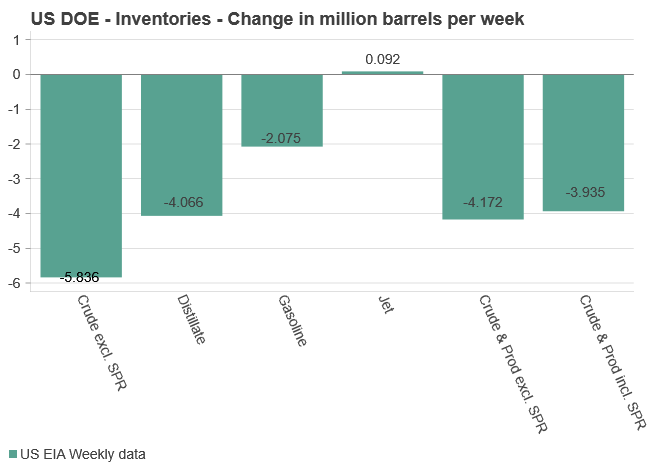
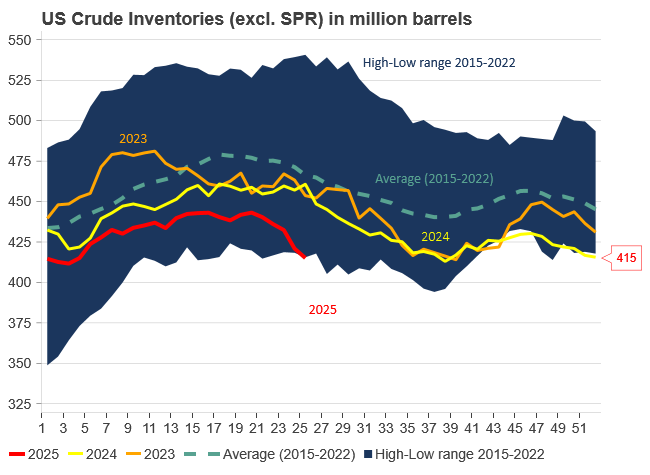
Analys
Bombs to ”ceasefire” in hours – Brent below $70

A classic case of “buy the rumor, sell the news” played out in oil markets, as Brent crude has dropped sharply – down nearly USD 10 per barrel since yesterday evening – following Iran’s retaliatory strike on a U.S. air base in Qatar. The immediate reaction was: “That was it?” The strike followed a carefully calibrated, non-escalatory playbook, avoiding direct threats to energy infrastructure or disruption of shipping through the Strait of Hormuz – thus calming worst-case fears.

After Monday morning’s sharp spike to USD 81.4 per barrel, triggered by the U.S. bombing of Iranian nuclear facilities, oil prices drifted sideways in anticipation of a potential Iranian response. That response came with advance warning and caused limited physical damage. Early this morning, both the U.S. President and Iranian state media announced a ceasefire, effectively placing a lid on the immediate conflict risk – at least for now.
As a result, Brent crude has now fallen by a total of USD 12 from Monday’s peak, currently trading around USD 69 per barrel.
Looking beyond geopolitics, the market will now shift its focus to the upcoming OPEC+ meeting in early July. Saudi Arabia’s decision to increase output earlier this year – despite falling prices – has drawn renewed attention considering recent developments. Some suggest this was a response to U.S. pressure to offset potential Iranian supply losses.
However, consensus is that the move was driven more by internal OPEC+ dynamics. After years of curbing production to support prices, Riyadh had grown frustrated with quota-busting by several members (notably Kazakhstan). With Saudi Arabia cutting up to 2 million barrels per day – roughly 2% of global supply – returns were diminishing, and the risk of losing market share was rising. The production increase is widely seen as an effort to reassert leadership and restore discipline within the group.
That said, the FT recently stated that, the Saudis remain wary of past missteps. In 2018, Riyadh ramped up output at Trump’s request ahead of Iran sanctions, only to see prices collapse when the U.S. granted broad waivers – triggering oversupply. Officials have reportedly made it clear they don’t intend to repeat that mistake.
The recent visit by President Trump to Saudi Arabia, which included agreements on AI, defense, and nuclear cooperation, suggests a broader strategic alignment. This has fueled speculation about a quiet “pump-for-politics” deal behind recent production moves.
Looking ahead, oil prices have now retraced the entire rally sparked by the June 13 Israel–Iran escalation. This retreat provides more political and policy space for both the U.S. and Saudi Arabia. Specifically, it makes it easier for Riyadh to scale back its three recent production hikes of 411,000 barrels each, potentially returning to more moderate increases of 137,000 barrels for August and September.
In short: with no major loss of Iranian supply to the market, OPEC+ – led by Saudi Arabia – no longer needs to compensate for a disruption that hasn’t materialized, especially not to please the U.S. at the cost of its own market strategy. As the Saudis themselves have signaled, they are unlikely to repeat previous mistakes.
Conclusion: With Brent now in the high USD 60s, buying oil looks fundamentally justified. The geopolitical premium has deflated, but tensions between Israel and Iran remain unresolved – and the risk of missteps and renewed escalation still lingers. In fact, even this morning, reports have emerged of renewed missile fire despite the declared “truce.” The path forward may be calmer – but it is far from stable.
Analys
A muted price reaction. Market looks relaxed, but it is still on edge waiting for what Iran will do

Brent crossed the 80-line this morning but quickly fell back assigning limited probability for Iran choosing to close the Strait of Hormuz. Brent traded in a range of USD 70.56 – 79.04/b last week as the market fluctuated between ”Iran wants a deal” and ”US is about to attack Iran”. At the end of the week though, Donald Trump managed to convince markets (and probably also Iran) that he would make a decision within two weeks. I.e. no imminent attack. Previously when when he has talked about ”making a decision within two weeks” he has often ended up doing nothing in the end. The oil market relaxed as a result and the week ended at USD 77.01/b which is just USD 6/b above the year to date average of USD 71/b.

Brent jumped to USD 81.4/b this morning, the highest since mid-January, but then quickly fell back to a current price of USD 78.2/b which is only up 1.5% versus the close on Friday. As such the market is pricing a fairly low probability that Iran will actually close the Strait of Hormuz. Probably because it will hurt Iranian oil exports as well as the global oil market.
It was however all smoke and mirrors. Deception. The US attacked Iran on Saturday. The attack involved 125 warplanes, submarines and surface warships and 14 bunker buster bombs were dropped on Iranian nuclear sites including Fordow, Natanz and Isfahan. In response the Iranian Parliament voted in support of closing the Strait of Hormuz where some 17 mb of crude and products is transported to the global market every day plus significant volumes of LNG. This is however merely an advise to the Supreme leader Ayatollah Ali Khamenei and the Supreme National Security Council which sits with the final and actual decision.
No supply of oil is lost yet. It is about the risk of Iran closing the Strait of Hormuz or not. So far not a single drop of oil supply has been lost to the global market. The price at the moment is all about the assessed risk of loss of supply. Will Iran choose to choke of the Strait of Hormuz or not? That is the big question. It would be painful for US consumers, for Donald Trump’s voter base, for the global economy but also for Iran and its population which relies on oil exports and income from selling oil out of that Strait as well. As such it is not a no-brainer choice for Iran to close the Strait for oil exports. And looking at the il price this morning it is clear that the oil market doesn’t assign a very high probability of it happening. It is however probably well within the capability of Iran to close the Strait off with rockets, mines, air-drones and possibly sea-drones. Just look at how Ukraine has been able to control and damage the Russian Black Sea fleet.
What to do about the highly enriched uranium which has gone missing? While the US and Israel can celebrate their destruction of Iranian nuclear facilities they are also scratching their heads over what to do with the lost Iranian nuclear material. Iran had 408 kg of highly enriched uranium (IAEA). Almost weapons grade. Enough for some 10 nuclear warheads. It seems to have been transported out of Fordow before the attack this weekend.
The market is still on edge. USD 80-something/b seems sensible while we wait. The oil market reaction to this weekend’s events is very muted so far. The market is still on edge awaiting what Iran will do. Because Iran will do something. But what and when? An oil price of 80-something seems like a sensible level until something do happen.
-

 Nyheter4 veckor sedan
Nyheter4 veckor sedanStor uppsida i Lappland Guldprospekterings aktie enligt analys
-

 Nyheter4 veckor sedan
Nyheter4 veckor sedanSilverpriset släpar efter guldets utveckling, har mer uppsida
-
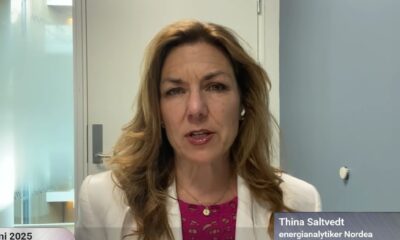
 Nyheter3 veckor sedan
Nyheter3 veckor sedanUppgången i oljepriset planade ut under helgen
-
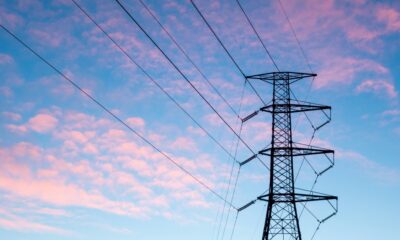
 Nyheter3 veckor sedan
Nyheter3 veckor sedanLåga elpriser i sommar – men mellersta Sverige får en ökning
-
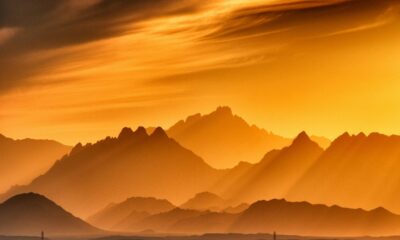
 Nyheter2 veckor sedan
Nyheter2 veckor sedanMahvie Minerals växlar spår – satsar fullt ut på guld
-

 Analys3 veckor sedan
Analys3 veckor sedanVery relaxed at USD 75/b. Risk barometer will likely fluctuate to higher levels with Brent into the 80ies or higher coming 2-3 weeks
-
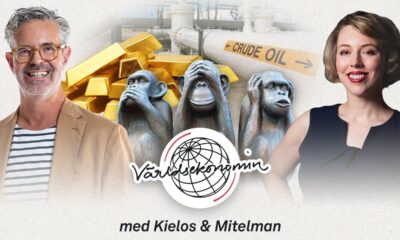
 Nyheter1 vecka sedan
Nyheter1 vecka sedanOljan, guldet och marknadens oroande tystnad
-
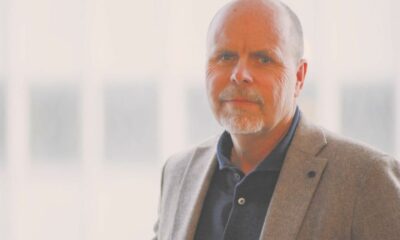
 Nyheter1 vecka sedan
Nyheter1 vecka sedanJonas Lindvall är tillbaka med ett nytt oljebolag, Perthro, som ska börsnoteras


